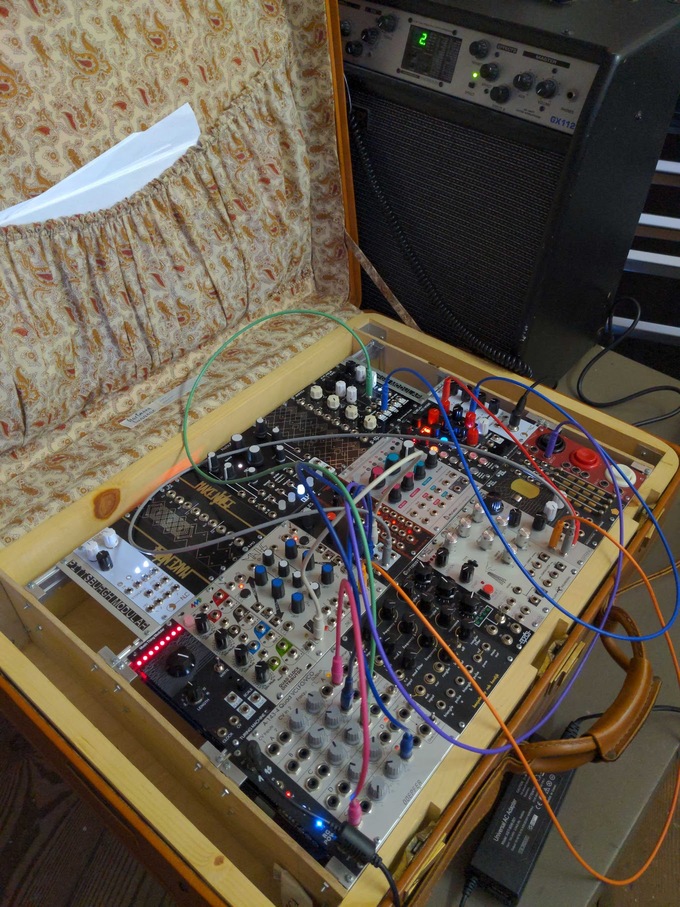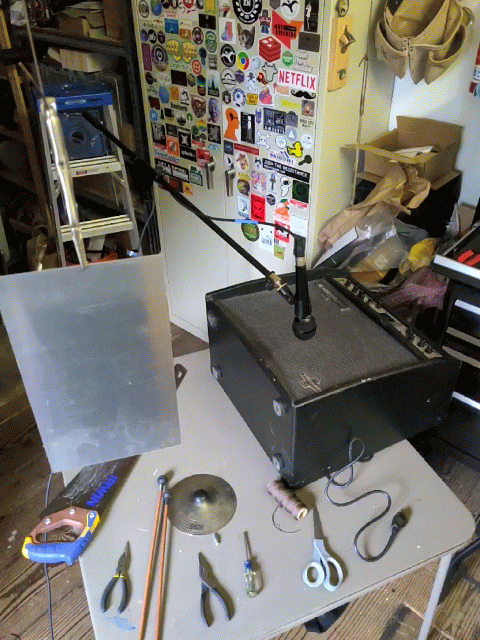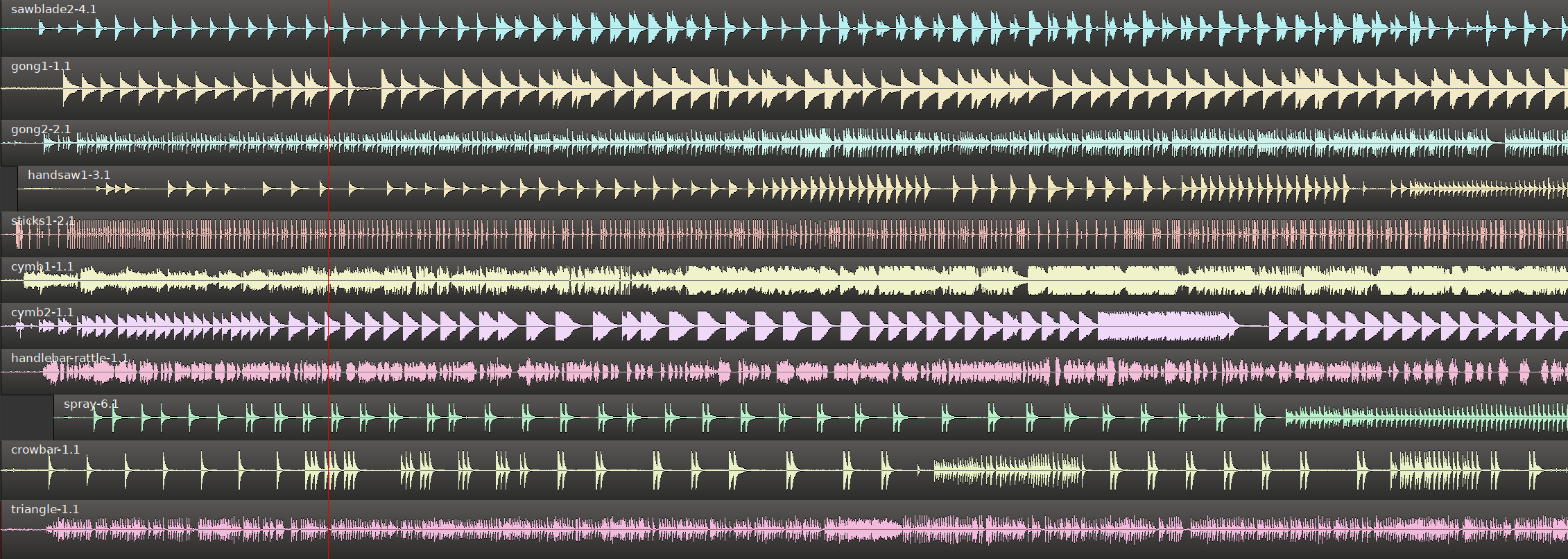Tue Jan 23 2024 16:59:42 GMT-0800 (Pacific Standard Time)
I started a ridiculous project like 9 years ago: To cut up the entirety of Michael Jackson's "Thriller" album into just the grunts and hoots, similar to what I did with Billy Idol all the way back in 2009.
This last weekend I found the project and realized just how close it was to completion, so I went ahead and finished it and published it.
So now I present to you: Thrilling Grunts. Enjoy.
Sun Mar 13 2022 20:00:00 GMT-0700 (Pacific Daylight Time)
Last week was the fourth and final week for the experimental music course I've been taking. Due to being busy with other things, I had put off the "homework" for a week and got back to experimentation this weekend.
Last week's lesson was all about synth techniques. What a doozy! I feel like that's a very difficult subject to cram into a 90 minute session. Even if you can be certain that people have some exposure to basic signal theory and techniques, it's really difficult to describe a patch and there's definitely some problems around expecting people to have access to specific modules (are formant and shepherd filters that commonplace? lol). As an exhibition, it was very cool...but as a teaching/learning session, I think it was a bit of a stretch.

I did 3 or 4 different patches, one of which was strongly inspired by one of Jamie Stewart's example patches in the class (although I made a couple small tweaks). I took some of the session audio and arranged it into this rough track:
Direct links to files here: flac mp3
Honestly, in a pretty dark place while making these. Stoked with how they turned out, but the mix could use a lot of love, something that I'm not going to put time into right now though.
Sun Feb 27 2022 21:30:00 GMT-0800 (Pacific Standard Time)
tags: music noise percussion audio sound
This week's "homework" for the experimental music course was pretty deep and had 5 possible assignments. One of these was to compose and record a short piece of music using only percussion (using techniques covered in class).
I'm not really a percussionist, so this seemed like a good challenge. Here is the final recording of what I ended up putting together this afternoon. Give it a listen while you read about the process below.
I think I remember my brother telling me that he was in the music program at the University of Oregon with Ches Smith, and that Ches used to gig with a sawblade used as a crash or a bell or something. Since much of our course material involved really nice shiny percussion instruments that I definitely do not own, I figured I would still give it an honest attempt starting with this sawblade as inspiration. I had an old/used skill saw blade around, and started by suspending that from the rafter.

Initial experiments showed that it sounded pretty good and had a nice ringing bell sound. When a playing it close to the microphone, however, the swinging and spinning made it pretty hard to capture the sound. I ended up adding a second tie to prevent it from rotating, and that helped a lot.
I also suspended a piece of sheet aluminum that have cut up previously for making eurorack faceplates. I didn't want to drill holes in it, so I first tried to compression fit two nuts on a bolt on either side. That failed horribly and quite dangerously. :) I instead used needle-nose vice grips and suspended it via that. The rich gong sound from a simple flat rectangular piece of aluminum was pretty surprising (to me)!
I also had the brass frame from a decorative air plant holder that a friend had gifted me several years ago. That was already hanging in the shop, so I used that as well since it had a nice triangle sound.

I think I recorded like 14 or 15 tracks and ended up using these final 11:

The track breakdown is something like this:
Aside from some pretty flagrant reverb on the sticks and a couple level adjustments, everything is just as I recorded it -- no edits, all timing mistakes are mine to own. As such, it is raw and could certainly using some mixing/equalizing at the very least, but I'm really happy with how it turned out.
Future improvements -- with more time, I hope to do some more experimentation with the sawblade, perhaps figuring out how to mount horizontally more like a cymbal. I will also experiment with adding loose screw/nut combinations to the blade to add some rattle or odd dampening. I think there is a notable lack of low-end bass in this work, and I've long wanted to experiment with tubular bass cannon type drums...so that would be another future experiment.
It was also clear from this experiment that the microphone I've used is wrong for this type of work. It's much much too directional and lots of tone was lost as the instruments changed their position or rotated. Something with a broader direction could have compensated for and possibly maintained some of the interesting tonal changes that were happening as things moved around (this was lost in process).
That's it for now. More homework later this week or next week!
Tue Feb 22 2022 21:30:00 GMT-0800 (Pacific Standard Time)
As I mentioned in the last blog, I'm taking a zoom course on Composing Experimental Music, we have optional "homework" assigned -- which is really a set of flexible techniques to experiment with and explore timbre.
In class, Jamie demonstrated several means of exploring amp feedback width stringed instruments (including the immediately recognizable autoharp!), and I really don't have any viable stringed instruments right now. I really wanted to make one out of scrap wood and rubber bands, but time didn't afford that this cycle (I hope to revisit sometime soon). It occurred to me that the springs inside the spring reverb tank might behave a little bit like oddly shaped "strings", so I performed some feedback experimentation.
In this experiment, I left the reverb tank input open, so all sound was internally generated through mechanical vibration of the springs -- either through externally tapping with hand or drumstick, or by the speaker vibrations resonating with the coils. This is what I had really hoped to explore.
I absolutely LOVE the industrial echoing machinery sounds of the spring reverb, but I wasn't going for that this time around.
I got some interesting resonances by playing with various effects settings and modulating the position of the tank and riding the effects controls (mostly volume).
From this experiment, I have put together one rushed/stupid video and one clip of excerpts.
I later set the amp on its back and had the tank sitting on the mesh facing down/vertical. This allowed me to adjust positions while being more able to monitor the effects controls with two hands. I worked with several varied effects modes, but mostly used the downward pitch shift in hopes of getting a lower frequency bass response and reducing the high-pitch static feedback tone that everybody can picture in their head right now.
It was a much longer session, but here are several edited excerpts:
Direct link is here: Homework 02b
I am pleased with the resonant tones/outcome of this experiment, and I believe that additional exploration with a bass cabinet or feeding back through a transducer (possibly through mechanical linkages of odd varieties) could yield even more interesting timbres.
Sun Feb 20 2022 00:30:00 GMT-0800 (Pacific Standard Time)
I'm taking Jamie Stewart's course on Composing Experimental Music, and it's already halfway through and I'm enjoying it tremendously. It's blazingly fast paced and is covering a TON of ground on so many varied topics really quickly.
All of the "homework" is optional and this course is just not for credit or anything, but one of the reasons I wanted to take it was to be exposed to some new possibilities and to nudge myself to do some more experimentation.
For the first assignment, I decided to dust off a synthesizer I built 20 years ago, the triwave picoswash. I ran it through a modeling amplifier that was scrounged from a dumpster that I later repaired (tho it's still fucked up, only one of the digits on the display is working). Jamie covered a little about frequency beating (not a new concept, but one I haven't explored much recently), so I decided to spend some time de/tuning the two sides of the triwave into giving some interesting beat patterns.
Of course, the triwave always sounds better when patched through the noise swash, and then I ran the amp in a reverb/delay mode with the parameters up basically all the way (tho it's hard to be sure with the broken display, heh).
So here's a brief clip from that session, just recorded on a phone:
The second class gave several assignments, and one of them involved capturing a field recording and then turning it into a composition using the DAW. It was a rather slow and mostly quiet Friday afternoon in my neighborhood, but I managed to get some sounds recorded and turned them into this piece here:
Here is the direct link to mp3 here: Homework 02a
I'm pleased with the way it turned out! I wanted to make some musique concrète while keeping some aspects of the source material clearly audible. I wanted it to sound like a field recording, but with some enhanced editing/mixing/structure/interest.
There are several more parts to the "homework" (all of it is optional, for fun/learning/experimentation), I have a bit more to finish up and share. More to come in a following blog entry.
Sun Jul 26 2020 16:00:00 GMT-0700 (Pacific Daylight Time)
tags: sound audio wld worldlisteningday listening fieldrecording portland pdx 2020 soundwalk oregon
This year, World Listening Day was on Saturday, July 18th, 2020. The global SARS-CoV-2 pandemic and civil unrest (caused by social injustice) have dramatically altered the world. I thought it would be interesting to try and recreate the soundwalk I did last year in hopes of making a recording that could demonstrate a sonic contrast.
In order to be more faithful to the previous recording, I took the liberty of doing the soundwalk on Friday, one day before the actual official World Listening Day. I met up with my colleague Wes downtown at noon, and we wore masks and stayed outdoors and socially distant. There were a few surprises along the way.
First, the wind was considerably stronger than prior years. I decided to try the windscreens that came with my in-ear binaural microphones, but I wasn't sure how they might be impacting the recording volume (plus, it was just really quiet downtown). Once we were walking for a few minutes, the wind really wasn't that bad and I'm not entirely sure how necessary the windscreens were (although they probably helped). The recording did end up being quite quiet, so I applied a constant 15dB amplification, which I think sounds pretty good but maybe calls up the background hiss/noise floor a bit more than I'd have preferred.
Second, the route I chose last year winds along the Willamette river via a stretch of private greenway (shared use path). Sadly, this year the path was closed due to construction in parts and covid-19 concerns. We ended up with more sidewalk time than I had hoped, which probably makes contrasting with the prior year more difficult. The upside, however, is that we got to find and explore some interesting new spaces, like a parking lot under the Broadway bridge. Ultimately, this detour caused us to be out recording longer, and we captured closer to an hour (compared to 50 minutes last year)
During our walk, I found it harder than usual to concentrate on my intentional listening. The sights and sounds of the city seemed more alien than they normally would, and so my mind was easily distracted and my focus drifted. While this is normal for me (and probably for most) during soundwalks, I found the sense of distraction elevated from previous times (especially visual distraction). Every new bit of graffiti seen brought me back to thinking about our current crises. I tried a new technique of purposefully "softening my gaze", and I think it helped fair amount. Before today, I genuinely didn't know that this was an actual thing, let alone that it's leveraged in Buddhism, anxiety therapy, and yoga (drishti...which I have unknowingly used both in eagle pose and while track-standing on a bicycle).
This is a binaural recording, so good stereo headphones work best. Click here to visit the archive.org page for this recording or just listen to it here:
See you next year for WLD.
Tue Jul 30 2019 21:00:00 GMT-0700 (Pacific Daylight Time)

I learned last night that Little Richard recorded a horrifying rendition of "The Itsy Bitsy Spider" in 1991 on Disney CD to support a pediatric AIDS foundation. Thanks Nate! While the cause is honorable, the content is certainly questionable. It almost kinda includes Debbie Gibson, but aside from a brief flop on the piano and some childish dancing, the contribution remains unclear.
In any case, Little Richard is one of the masters of the grunt/whoop/wat style of singing/moaning...so I tried a very low-effort cutup. The rap in the middle got some special attention. Enjoy!
Thu Jul 18 2019 13:00:00 GMT-0700 (Pacific Daylight Time)
tags: sound audio wld worldlisteningday listening fieldrecording portland pdx 2019 soundwalk oregon
Background: 5 years ago I decided to guide a soundwalk for World Listening Day.
5 years later, I decided to do it again.
My employer is awesome. We are encouraged as part of our happy employment and ongoing professional development to engage in "thrive time" -- essentially expansive work that may not be directly related to daily business deliverables, but work that makes us better, stronger, healthier, and happier. I offered this sound walk.
Here is the recording I made on World Listening Day in 2019 in Portland, OR. It's a binaural recording, so listening on headphones with little/no background sound works best.
Click the link above or listen to it here:
See you next year for WLD.
Thu Apr 04 2019 20:45:00 GMT-0700 (Pacific Daylight Time)
tags: sound audio noise dryice experiment dorkbotpdx dorkbot pdx ^h
Earlier this month at the end of a Dorkbot meeting, somebody had a chunk of dry ice. I put it into the empty popcorn bowl and recorded it.
Click the link above or listen to it here:
Enjoy!
Tue Oct 23 2018 18:56:44 GMT-0700 (Pacific Daylight Time)
(image attribution: wellcome collection)
It must finally be fall...because the crows are in full effect in Portland.
I took a recording of them this evening in Waterfront Park. Enjoy!
Mon Jan 02 2017 10:19:26 GMT-0800 (Pacific Standard Time)
I made some textures with a synthesizer in sub-zero temperatures. Pretty fun, even with just a small number of starter modules...
Mon Jan 25 2016 02:05:21 GMT-0800 (Pacific Standard Time)
Sat Jan 02 2016 23:54:31 GMT-0800 (Pacific Standard Time)
On more than a few occasions, I've wanted to be able to software-record the sound coming out of my computer speakers. Many users faced with similar problems resort to using pulseaudio as their sound system, which is reasonble, because it provides a very extensible/pluggable framework for sound. Unfortunately, my experience with pulseaudio in the past has been "meh", probably due in large part to my heavy use of Pd. So I've stuck with ALSA through the years when doing simple stuff, resorting to jack when doing more complicated routing between applications. Simply recording what's playing seems simple enough...right? Not so much...
I guess some (nicer?) sound cards provide a built-in hardware recording channel that can mix back in the currently playing audio. Most built-in ones, like the one in my aging T410, do not. After some sleuthing, I discovered that ALSA's plugin system does, in fact, provide a way to do this. I'll describe the process here, but it's basically ripped from this thread where kokoko3k serves up the right approach: https://bbs.archlinux.org/viewtopic.php?id=147852
There's an ALSA kernel module called snd_aloop that "provides a pair of cross-connected devices, forming a full-duplex loopback soundcard". With just a little fiddling, you can create a "looprec" device that has loops back the audio output into a new recordable ALSA device. The steps, just like in the above-mentioned post, are:
$ sudo modprobe snd_aloop
(this inserts the relevant kernel module into the kernel)
create/edit ~/.asoundrc and paste in the following (a bit of alsa black magic):
pcm.!default {
type asym
playback.pcm "LoopAndReal"
#capture.pcm "looprec"
capture.pcm "hw:0,0"
}
pcm.looprec {
type hw
card "Loopback"
device 1
subdevice 0
}
pcm.LoopAndReal {
type plug
slave.pcm mdev
route_policy "duplicate"
}
pcm.mdev {
type multi
slaves.a.pcm pcm.MixReale
slaves.a.channels 2
slaves.b.pcm pcm.MixLoopback
slaves.b.channels 2
bindings.0.slave a
bindings.0.channel 0
bindings.1.slave a
bindings.1.channel 1
bindings.2.slave b
bindings.2.channel 0
bindings.3.slave b
bindings.3.channel 1
}
pcm.MixReale {
type dmix
ipc_key 1024
slave {
pcm "hw:0,0"
rate 48000
#rate 44100
periods 128
period_time 0
period_size 1024 # must be power of 2
buffer_size 8192
}
}
pcm.MixLoopback {
type dmix
ipc_key 1025
slave {
pcm "hw:Loopback,0,0"
rate 48000
#rate 44100
periods 128
period_time 0
period_size 1024 # must be power of 2
buffer_size 8192
}
}
That's it! Your recording software should now have a device available called "looprec", and if you record from it you'll get whatever is playing on your speakers. You can make this permanent by adding the snd_aloop module to /etc/modprobe.d/sound.conf.
Since you've made it this far, I'll share what I was trying to record: http://websdr.ewi.utwente.nl:8901 -- which is pretty much the raddest thing ever.
Tue Apr 07 2015 22:49:41 GMT-0700 (Pacific Daylight Time)
Super interesting read about some archaeoacoustic research in Serbia:
(via mediateletipos)
There's only a single sound clip available right now, but the effect is pretty mesmerizing. It's wild to imagine ancient people performing sacrificial blood rituals while bathed in this soundscape.
Sat Jan 03 2015 12:54:22 GMT-0800 (Pacific Standard Time)
This is great. If you're interested in active listening, field recordings, soundscapes, or amibent sound/music, this is a pretty good primer and talks about the origins of the term "acoustic ecology" as a movement.
Sat Jul 19 2014 21:12:20 GMT-0700 (Pacific Daylight Time)
tags: sound audio listening worldlisteningday fieldrecording recording
In observance of World Listening Day 2014 (July 18th), I guided a lunchtime soundwalk around parts of downtown Portland, OR. I decided to organize only at the last minute, and there were 5 of us who showed up for the nearly hour long sound walk.
We started with short discussion about active listening and purposeful sound observation and some of the philosophy/ideas behind it. We walked and listened for about 20 minutes, then had a short chat about what we had noticed so far and what we thought was interesting in the act of observing. We continued on for another 35 minutes or so and completed a wide loop. The small group of participants seemed to have a really good time (and it turned out to be some decent exercise too).
I recorded the walk on my binaural in-ear microphones with a Zoom H2. The raw recording is available on archive.org: Portland, OR World Listening Day Soundwalk.
Embedded here:
See you next year for World Listening Day!
Wed Feb 24 2010 00:53:44 GMT-0800 (Pacific Standard Time)
tags: infiltrationlab radio noise audio sound
Infiltration Lab played a live, hour-long drone/noise set on KBOO FM on February 1st, 2010.
In the unfortunate event that KBOO loses funding or they change their url scheme or de-archives material or bombs hit Portland or whatever, I have also archived the show on archive.org. Hopefully this embedded player continues to work:
A few random tech details: I played the set on my audiopint computer that I built a couple years ago, running some Pd patches that I designed specifically for this show. As usual, the computer (as underpowered as it is!) had no problems keeping up. All sounds in the recording were rendered through Pd in realtime. Some audio material (for the granular synthesis) was taken from a(n unnamed) commercial recording, and the spoken sample material was mixed blind (previously unheard by me) from a psychological tape sourced at the Goodwill bins.
This piece is intended to be a contrast of sorts, a juxtaposition, and an overt psychological response to the reflection of time collapse. There really is no time. If your current self could revert to its earlier self in an instant, what would that event sound like?
Many thanks to Sean for having me. May radio live on!
Wed Jun 24 2009 22:59:18 GMT-0700 (Pacific Daylight Time)
Sometimes when bogged down by responsibility I can find it rejuvenating to embrace the right kind of distraction.
So my distraction involved hearing a radio cut of the Billy Idol hit "Cradle of Love" and finally following thru on a long-time desire to cut the thing into its most fundamental (read: important) parts: The grunts.
"That's right!" Sir Cyborg Himself. Despite having such a HUGE hit in the 90s, there are probably between zero and 3 people on the planet who actually know all the lyrics -- it's a slurred bozo fest of nonsense sexual innuendo and rockstar spittle. Simply brilliant.
So I leave you with "Rock The Cradle of Love Grunts".
Wed Apr 01 2009 23:38:20 GMT-0700 (Pacific Daylight Time)

I recently acquired a certain netbook so that I could be frugal but still have the ability to hack while mobile. Of course, I have to run Debian...it's a curse...but it rules.
Surprisingly, things work altogether very very well. I still don't think I'm that savvy, but I've gotten things to play together quite nicely. I will create a real page and post my results/settings/findings soon....but I made a stupid simple hack tonight that I thought I'd share.
So I'm running Fluxbox again. It's clean, simple, and takes up very little screen real-estate. It's been a few years, but it's as elegant and non-intrusive as I remember it.
The default keys file for fluxbox has commands that grok asla (via alsactl) and are able to nudge the volume up/down based on the magical function modifier keys (like Fn+F7 or Fn+F8 on the Wind). That's all great...but at least with the sound apps I run (including Flash!), the defaults aren't enough because this "Front" control keeps stomping on things (eg. it apparently needs to be massaged after the Master is massaged). I wish this wasn't the case, it's stupid, I should complain...Whatever.
Scripts to the rescue.
For the MSI Wind, I made three scripts, one does muting, the other two do volume up/down. They look something like this:
#!/bin/bash
for control in Master Front ; do
amixer sset ${control},0 1+
done
aplay ~/media/sounds/volume_change.wav
The 1+ indicates volume up, change to 1- for volume down.
And then in ~/.fluxbox/keys we can map things like:
176 :Exec ~/bin/volume_up 174 :Exec ~/bin/volume_down 160 :Exec ~/bin/volume_mute
What this provides is two things. First, when you press Fn+F7, for example, the Master and Front volume levels will both decrement. The Front is changed last, so that the actual volume output level is applied. Secondly, the 'aplay' line gives a little chime to audibly indicate the volume level...something akin to the sound that those $2000 Macintoshes make.
I found this bink sound on freesound and think it works quite well.
Until I can create a real page for my Wind setup, scream loud and enjoy the hack.